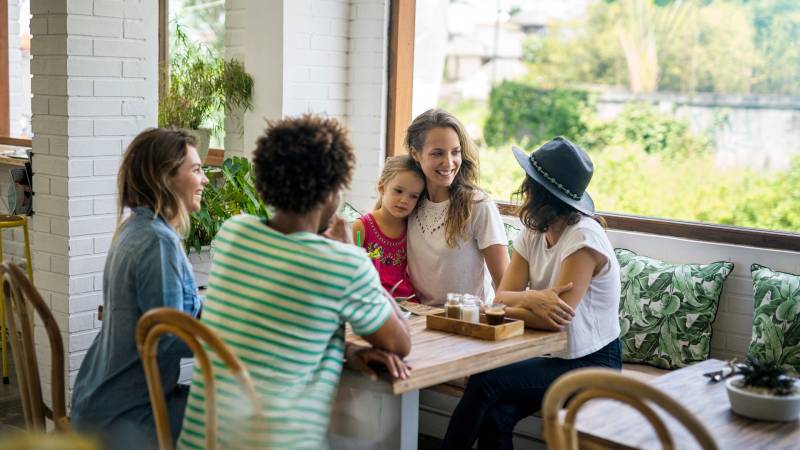NPR’s Rhaina Cohen has taken a close look at friend-powered parenting, joining shared households to see how neighbor-and-friend alliances can break the isolation of modern parenthood. We’ll talk about the challenges of communal living and what parents gain—emotionally, practically, even financially—when they raise their kids with their friends. Cohen’s recent piece for the Atlantic is “A Grand Experiment in Parenthood and Friendship.” Would you raise your kids with your best pals?
What It’s Like to Parent With Your Friends

Guests:
Rhaina Cohen, producer and editor for the NPR Documentary podcast Embedded; author of "The Other Significant Others: Reimagining Life with Friendship at the Center" and the Atlantic piece, "A Grand Experiment in Parenthood and Friendship"
Phil Levin, founder, Live Near Friends - helps people live right next door to friends and family
Show Highlights
The Rise of Friend-Powered Parenting
Journalist Rhaina Cohen has been tracking a growing movement among parents who are choosing to live with—or right next to—their closest friends as a way to ease the burdens of raising children. In her recent Atlantic piece, “A Grand Experiment in Parenthood and Friendship,” Cohen profiles families like Charlotte and Raffy Grinberg, who relocated from Boston to Washington D.C. to live beside their best friends—all of them raising young kids.
Phil Levin, founder of Live Near Friends, a service that helps facilitate these arrangements, says the trend is being driven by the isolating nature of modern parenthood. Cohen notes that many millennial parents are beginning to reject the idea that raising kids means giving up meaningful social connections. Instead, they’re actively seeking new ways to stay close to their communities while building family life.
Benefits of Shared Parenting
Families living near close friends describe a mix of emotional and practical advantages. Cohen says that, for Grinberg, her family’s move made everyday tasks—like going out for a movie—far simpler. Levin adds that the proximity of trusted neighbors creates what he calls “baby monitor distance”—a setup where parents can hand off the monitor and step out, knowing their child is in good hands.
One caller, Jeff, who Cohen interviewed, raised his son in a 14-household cohousing community. Now in college, his son still visits neighbors of all ages when he returns home—30-somethings and 90-somethings alike. “I definitely felt great value,” Jeff says. “I’m really happy that our cohousing community gave him a life where he’s got friends from lots of different decades.”
Another caller, Sharon, reflects on being raised by an extended network—her aunt, uncle, grandparents, and neighbors. That kind of collective care, she says, left her with “a warm, supportive, caring environment” that shaped her long-term well-being.
Practical Realities and Challenges
Despite the appeal, Cohen, Levin and many listeners note the logistical and emotional complexities of making these arrangements work in real life. Differences in parenting styles, income levels and expectations around shared property can create tension, and the legal and financial planning required can be daunting.
Cohen points out that even initiating these conversations can feel awkward—there’s often no “conversational template” for asking friends if they want to raise kids together. Most available housing, she adds, still caters to single-family units, limiting structural options for co-living. Levin’s organization tries to fill that gap, offering support on everything from loan logistics to legal frameworks.
Evolving Forms and Logistics
Friend-powered parenting isn’t one-size-fits-all; the structures are shifting and adapting as families grow. Levin, whose early co-living experiment known as “the Radish” is supporting a cohort through the baby and toddler years, is now developing a new community model designed for families with school-aged children.
For those not ready to fully cohabitate at all, Cohen emphasizes that smaller changes can still go a long way. Creating kid-friendly homes, she says, can make it easier for parents to visit each other regularly. She shares her own example: a standing weekly visit to a parent-friend’s house after the kids are asleep.
Ownership and financing models vary widely. Some groups co-purchase duplexes with separate mortgages, while others, like the Radish, have embraced collective ownership—with 23 co-owners across 20 units. These arrangements can unlock shared luxuries, like hot tubs, that Levin jokes “no single individual should ever own.”
Policy changes are also making these living setups more feasible. Levin raises California’s recent ADU (Accessory Dwelling Unit) laws, which allowed his group to add housing on their property—something he says “would not have been possible five years ago.”
Community Input and Lessons
Levin emphasizes the importance of intentionality and communication when it comes to ideating and executing a communal living situation. Having a central organizer to rally the group and keep plans on track is invaluable, he says.
Whether through cohousing, shared backyards, or simply keeping doors open for weekly visits, friend-powered parenting reflects a growing desire to raise children within connected communities. It’s about “picking your own family,” Irene says. And for Vicky, it means offering kids “role models who may remain in their lives.”
This content was edited by the Forum production team but was generated with the help of AI.